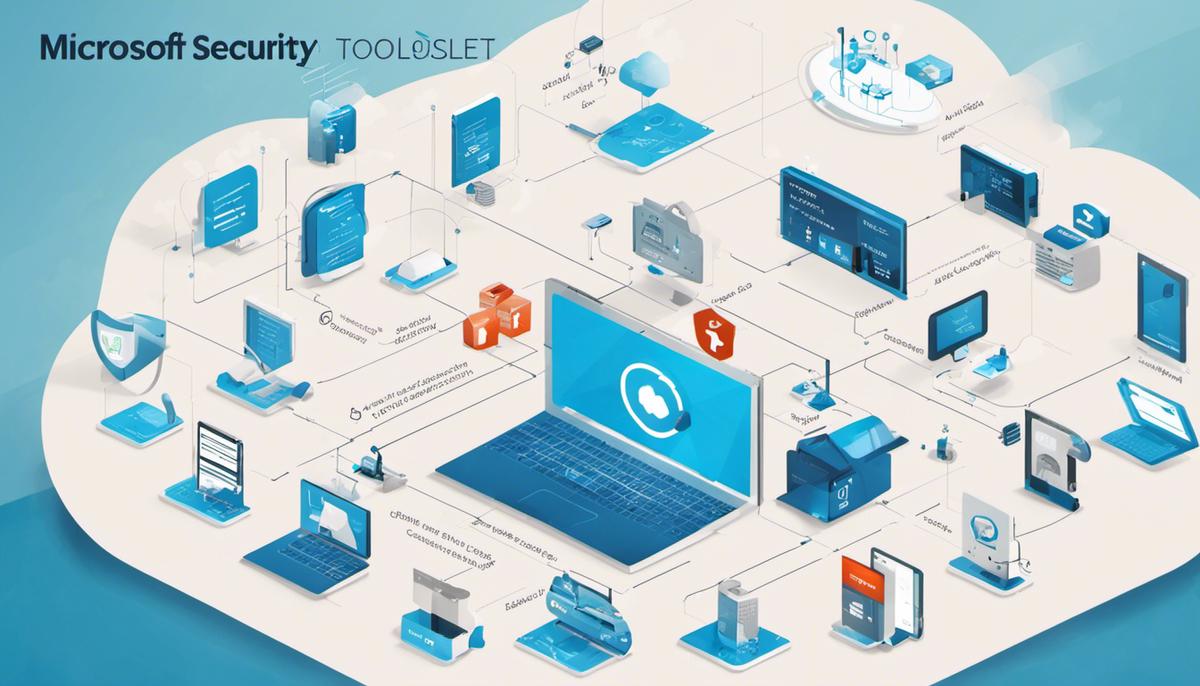Microsoft’s Azure provides a robust suite of Azure security tools designed to help organizations protect their data and applications hosted on the platform. This overview examines the essentials of these tools, their applications, and the crucial role they play in mitigating potential risks. It also delves into their various features and capabilities and reveals how they can be used to automate security tasks to streamline management and maintain high-level security vigilance.
Understanding Azure Security Tools
Unveiling Azure Security Tools: The Game-changer in Cloud Security
The advent of dynamic cloud-based technologies such as Azure has not only streamlined the ability to create, manage, and implement applications across a wide global network but, more importantly, has amplified the necessity to secure data and services robustly. It’s within this context that Azure Security Tools were conceived and developed, becoming vital assets, optimizing data and service security.
Azure Security Tools comprise an extensive suite of inbuilt security provisions designed to bolster security within the Azure environment. These tools span access management, threat protection, data protection, security management, and hybrid security, ensuring an all-rounded fortification strategy.
One essential component is Azure Security Center, a robust security management system equipped to provide threat protection for data services not only on Azure but across virtual machines and networks. This tool offers notable features such as cloud security posture management (CSPM) for proactive policy compliance and cloud workload protection (CWP) for threat mitigation.
Another indispensable asset is Azure Active Directory, a comprehensive, intelligent identity and access management solution facilitating secured and seamless access. Its implications range from single sign-on to multi-factor authentication, securing connections across users, devices, applications, and data.
Azure Information Protection is yet another key tool that ensures data protection. This tool empowers organizations to classify, label, and protect documents and emails with a focus on “data at rest.”
Azure Key Vault flexibly handles cryptographic keys and secrets utilized by the cloud applications and services, thereby ensuring potent access management.
By bridging the domains of security intelligence, attack analytics, and threat intelligence, Azure Sentinel is an advanced SIEM tool, that helps in detecting, preventing, and responding to threats.
Azure DDoS Protection is a dedicated tool that safeguards Azure applications from the impacts of DDoS attacks by leveraging machine learning, DDoS traffic analytics, and rate limiting.
The importance of these Azure Security Tools cannot be overstated. As cyberattacks and data breaches proliferate, having a fortified cloud space becomes paramount. These tools not only deter potential threats but also help maintain regulatory compliance.
With Azure Security Tools, organizations have, at their disposal, an adaptive and intelligent security architecture built around five distinct layers of security: identity & access, threat protection, information protection, security management, and infrastructure security. This security structure can safeguard applications, data, and infrastructures, enabling organizations to enjoy the vast potential of Azure services without compromising security.
Finally, Azure Security Tools are innately receptive to the breadth of Azure’s AI and ML capabilities. This ensures that companies are always ahead of evolving threats, allowing them to respond to threats rather than reacting to them preemptively.
In summary, Azure Security Tools, with their potent cybersecurity capabilities, are unarguably critical assets that offer a safe, secure, and robust cloud environment. Whether it is access management, threat protection, data protection, or hybrid security, these tools promise extensive security coverage, providing organizations the confidence to grow their businesses without fear of compromised security.
Features and Capabilities of Azure Security Tools
Continuing our dive into the comprehensive security ecosystem of Microsoft Azure, it’s worth highlighting additional core elements and capabilities of Azure Security Tools, particularly on aspects such as cloud-native security, incident response, analytics, etc. These aspects will further illuminate the extensiveness of resources that Azure provides to ensure a fortified and resilient digital environment.
First off, there’s Azure Advanced Threat Protection (ATP). This cloud-based email filtering service is an ace up Azure’s sleeve. Azure ATP offers sophisticated protection against unknown malware and viruses while providing comprehensive reporting features to help one understand their organization’s threat landscape.
Next, Azure Network Security provides a holistic view to safeguard the infrastructure against different attacks. Network Watcher, Firewall, DDoS Protection, and Virtual Network TAP form a solid line of defense, ensuring only secure and genuine connection points.
Azure Security Benchmark is another key player, offering a collection of high-impact security recommendations. In line with industry standards, it serves as a brilliant guide, helping organizations stay a step ahead in mitigating potential vulnerabilities.
Microsoft’s Azure Managed Applications offer a unique value proposition, allowing users to deploy and operate applications in a secure container inside the customer’s subscription. This enhances user control over security policies and ensures data protection through considerable insulation.
The value of Azure Security Lab also cannot be overstated. With isolated environments for testing and validating security vulnerabilities without affecting live services, it is an essential tool to stress-test the security architecture and identify points of improvement.
Finally, let’s not forget the highly powerful Azure Security Score. Working in concert with the Security Center, it provides a quantifiable measure of your security posture. It offers a consolidated view of security health, making it easier for teams to spot gaps and take even better preventative measures.
In conclusion, while Azure offers immense flexibility and scalability, its dedication to maintaining a secure and robust framework is truly compelling. From front-line defense mechanisms to post-incident review tools, Azure’s suite of security tools is comprehensive and intelligently crafted, ensuring user confidence in the path toward secure digital transformation.
Remember: security isn’t a one-time setup – it’s an ongoing journey. Microsoft Azure’s expansive security toolset is a testament to this viewpoint, assisting organizations in sustaining and constantly improving their cybersecurity posture. So, sit back, let Azure take care of the worries, and focus on what’s really important – driving business value and progress.

Application of Azure Security Tools
In exploring the application of Azure Security Tools in real scenarios, the conversation naturally extends beyond the Azure pillars already discussed, namely Security Center, Active Directory, Information Protection, Key Vault, Sentinel, DDoS Protection, and Advanced Threat Protection (ATP). It’s crucial to bear in mind that Azure’s security strategy stretches beyond these powerful tools. Much of Azure’s security prowess hinges on additional tools like Azure Network Security, Azure Security Benchmark, Azure Managed Applications, Azure Security Lab, and Azure’s Security Score. Each has its place in bolstering the security posture of Azure users in real-world scenarios.
Starting with Azure Network Security
, this high-powered resource handles the fundamental role of enforcing and controlling network traffic. It employs the infrastructure of network virtual appliances, firewall solutions, and effective vulnerability management. In a real-world scenario, an example of Azure Network Security can be seen in global corporations that maintain a network of devices and need to ensure secure communication between them without risking the exposure of sensitive data.
Azure Security Benchmark
is another tool that plays a significant part in maintaining Azure’s security standards. It functions as a sourcebook for security best practices that Microsoft has honed over the years. It details the core functionalities and features of how Azure operates. Real-world usage might involve businesses in highly regulated industries utilizing this tool for secure baseline configurations.
Bringing Azure Managed Applications
into the equation, this tool takes the lead in managing apps’ lifecycle with the backing of Azure. It facilitates consistent, repeatable deployments in a secure environment. For instance, startups and small businesses, with tight resources and timelines can leverage managed applications to save development time and fast-track their deployment.
Stepping into the Azure Security Lab
, this sandbox environment is a truly revolutionary concept. It allows security researchers to confidently test and research security vulnerabilities within Azure frameworks without endangering the broader Azure ecosystem. It lends itself to real-world scenarios where companies extensively test their Azure-based projects’ security before deploying them on the live environment.
Last but not least comes the Azure Security Score
, a crucial tool offering comprehensive security assessments. It generates insights on an organization’s security postures and offers actionable recommendations for improvements. For any company leery of security risks, Azure Security Score provides an indispensable checkpoint to evaluate and bolster their data security.
In conclusion, Azure’s toolkit brims with resources to support its users’ comprehensive security needs effectively. Tools like Network Security, Security Benchmark, Managed Applications, Security Lab, and Security Score each play an integral part in maintaining Azure’s security posture fit to tackle real-world scenarios. The Azure Security toolbox is a testament to Microsoft’s commitment to robust, adaptable, and seamless security solutions.

Automating Security Activity with Azure
It’s time to delve deeper into the innovative world of Azure Security Tools and how they can be harnessed to automate vital security tasks. With such expansive security offerings already covered, two key aspects that are yet to be discussed stand out – Azure Logic Apps and Azure DevOps. These powerful tools paint a complete picture of how Azure’s array of security components can be weaponized to automate and streamline security operations.
First on the agenda is Azure Logic Apps. This cloud-based service provides users with the capability to schedule, automate, and orchestrate tasks, business processes, and workflows when the need arises. It utilizes a no-code approach, breaking down barriers for non-tech-savvy individuals, and allowing advanced automations to be created with relative ease.
In the scope of cybersecurity, Logic Apps can connect diverse systems and services, both inside and outside of Azure. This enables automatic response to system events such as triggering alerts, initiating threat investigation procedures, or even integrating with remote security tools. All of this culminates in a fully automated, systematic response to potential threats in real-time, making Azure Logic Apps an invaluable weapon in the cybersecurity arsenal.
On the other hand, Azure DevOps demands attention. This extends software lifecycle management by consolidating the vital phases of coding, testing, delivery, and monitoring into cohesively interconnected processes that can be decidedly expedited by means of automation.
From a security standpoint, Azure DevOps gives the power to integrate powerful security testing tools within the development pipeline seamlessly. It allows the implementation of different security mechanisms during development stages, like code analysis, fuzz testing, or vulnerability scanning, all being automated to run with each build process.
Diving deeper, Azure DevOps also facilitates the inclusion of Infrastructure as Code (IaC) mechanisms, which can be used to keep infrastructure configuration secure and consistent across deployments. Security policies and configurations can be defined as code, allowing automated checks before deployment. This makes it possible to identify potential vulnerabilities or non-compliance to security regulations early on in the development cycle.
Key to note is the reality that not all of Azure’s security tools function in isolation. The symbiosis between Azure Logic Apps and Azure DevOps, for instance, is worth paying attention to. Logic Apps can be used to trigger Azure DevOps pipelines, providing both the automatic response capabilities of Logic Apps and the comprehensive testing and deployment process of Azure DevOps.
These tools exemplify the commitment Azure puts into helping organizations automate not just simple tasks but complex operational and security-driven processes. With effective utilization of these tools, a robust, highly automated cybersecurity framework can be set up, allowing organizations to focus more on their strategic goals and less on the continuous threat of cyber attacks.

Staying Updated with Azure Security Tools
It’s essential to maintain a forward-thinking approach when navigating the rapidly evolving world of Azure security tools. Leveraging several unexplored resources will ensure a cutting-edge approach to Azure security trends.
Azure App Service Environment (ASE):
By implementing Azure App Service Environment, you gain an isolated and dedicated environment for securely running App Service apps at high scale. ISE is perfect for application workloads that require high-scale isolation, secure network access, or even improved performance. Keeping up with the regular updates of this tool can provide an edge for those looking to sharpen their security environment.
Azure Automation:
Azure Automation delivers a cloud-based automation and configuration service that provides consistent management across your Azure and non-Azure environments. It consists of process automation, update management, and system configurations to ensure stability efficiency within deployments across hybrid environments.
Azure Policy:
Azure Policy is a service in Azure that you use to create, assign, and manage policies. These policies enforce different rules and impacts over your resources, helping you stay compliant with your corporate standards and service level agreements. Azure Policy executes an evaluation of your resources, scanning for those not compliant with the policies you have assigned.
Azure Security Best Practices & Patterns:
Microsoft regularly updates Azure’s recommended security best practices and patterns. These documents provide crucial insights into how to protect applications and data on Azure. Understanding these patterns and best practices can help organizations form their own cloud-appropriate defenses.
Azure Advisor Security Assistance:
Azure Advisor gives you personalized information on Azure best practices. It includes a dedicated advisor for security, which evaluates resources for vulnerabilities and suggests remediation steps.
Azure Logic Apps Connector:
Staying updated with the latest connectors available within Azure Logic Apps helps to streamline critical processes. A connector is a proxy or a wrapper around an API that allows the underlying service to connect with Azure Logic Apps, Microsoft Power Automate, and Microsoft Power Apps.
Microsoft Azure continuously strives to innovate and automate complex operational and security-driven processes. It is crucial for tech enthusiasts to regularly engage with Microsoft Azure’s official blogs, social media channels, webinars, and online forums to stay abreast with the latest trends and developments.
Investing in Microsoft’s cloud certifications, such as Azure Security Engineer Associate or Azure Architect Expert, can also play a significant role in amplifying your knowledge of Azure Security Tools.
Navigating the future of Azure’s security is about persistent learning, staying connected, and being ahead in adapting to new features, trends, and tools as they roll out to the platform.
Adapting and evolving with technological advancements is key to enhancing data protection and overall cybersecurity. The Azure Security Tools offered by Microsoft are continuously updated and improved, with fresh enhancements curated to address emerging security threats. Staying updated with these developments not only ensures that one is leveraging the full potential of these tools but also significantly contributes to an organization’s overall security posture. By understanding the dynamics of Azure Security Tools, individuals and businesses are better equipped to navigate the digital landscape, securing their assets against threats and breaches.

